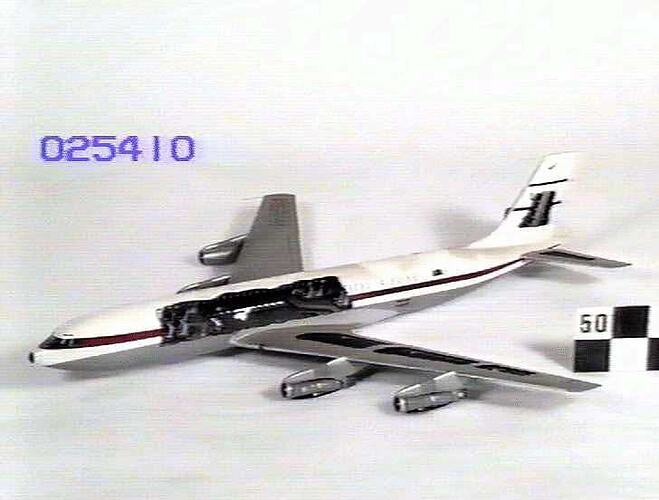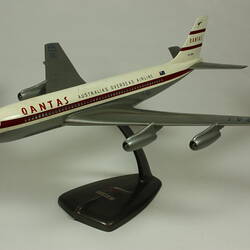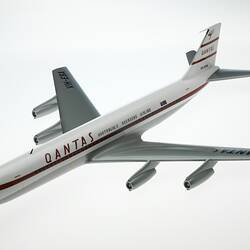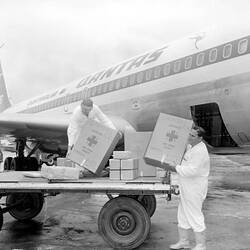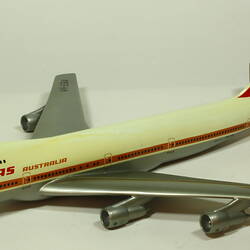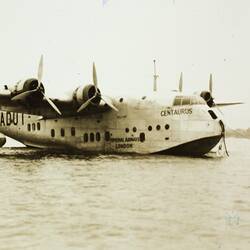Summary
Scale model built for the Museum by Mr B.D. Hede in 1963. It is painted to represent a Qantas Empire Airways Boeing 707-138B with the original paint scheme worn by these aircraft in the early 1960s. It features 'cut-away' sections in the wing, fuselage and tail to illustrate construction for display purposes.
Aircraft History:
Developed from the Model 367-80 first flown in 1954, the first Boeing 707 flew at Seattle on 20 December 1957 and entered airline service the following year. The British-built De Havilland Comet had demonstrated the potential of the four-engine jet airliner in the early 1950s but structural failures slowed progress in Britain allowed American aircraft manufacturers such as Boeing to establish a dominant position in jet airliner development which has only recently been challenged by Airbus Industries in Europe. The 707 quickly became the most popular long haul international jet airliner allowing limited stop or non-stop intercontinental services with lower costs, greater speed and comfort than the piston-engine machines they replaced. The Sydney-London flight time could be cut from 63 hours in a piston engine Lockheed Super Constellation to just 33 hours in a Boeing 707. While still expensive, international air travel was now possible for many Australians. Immigrants increasingly arrived by air.
In Australia, the government-owned Qantas Empire Airways placed an order for seven Boeing 707-138 aircraft in 1956. The 707-138 was a shortened fuselage model designed specifically for Qantas. The first aircraft, VH-EBA was delivered to QEA in 1959 with the others following shortly thereafter. VH-EBA was the first turbojet aircraft to be given a civilian registration in Australia. Crew training took place at Avalon airfield near Geelong in Victoria. The 707 was not permitted to operate from Melbourne's Essendon airport which stimulated pressure for a new airport to be built. QEA had to fly Melbourne passengers to Sydney to connect with the London flight, the first of which left on 15 October 1959. A Sydney-Tokyo 707 service began in November 1961. The new 707 fleet were later marketed as 'V-jets' and carried this name on their tails. During the Vietnam war, Qantas 707's were frequently used to fly Australian troops in and out of Saigon. In Melbourne, 707 spare parts were made at the Commonwealth Aircraft Corporation factory in Port Melbourne. The RAAF also operated the 707 from 1979 after taking delivery of two ex-Qantas aircraft. Additional 707s were later purchased and converted as air-to-air refuelling tankers to support the RAAF strike capability. These aircraft were retired in 2008. Qantas' first 707, VH-EBA was purchased in the UK by a syndicate in 2005 and flown back to Australia. It is currently displayed at the Qantas Founders Museum in Longreach, Queensland.
Physical Description
The winged kangaroo symbol was created by Sydney designer Gert Sellheim, and first appeared in January 1947 to coincide with Qantas' introduction of Lockheed L749 Constellations. These aircraft began operating on the UK service in December 1947. They were the first Qantas aircraft to carry the Flying Kangaroo and the first to operate right through to London with Qantas crews. The Flying Kangaroo was later placed in a circle.
More Information
-
Collecting Areas
-
Acquisition Information
Purchase
-
Modelmaker
Mr B. D. Hede, Glenroy, Greater Melbourne, Victoria, United States of America, by 1963
-
Manufacturer of Item Modelled
Boeing Aircraft Corp, Seattle, Washington, United States of America, circa 1958-1959
-
Owner of Item Modelled
Qantas Empire Airways Ltd, Sydney, Greater Sydney, New South Wales, Australia, Jul 1959 - 1967
-
Inscriptions
Painted on either side of vertical stabliser fin: [red flying kangaroo logo with black outline wing] / [red line] / 'QANTAS' [red lettering] / [red line] / 'VH-EBA' [black lettering] Painted on either side of fuselage: 'QANTAS' [red lettering] / 'AUSTRALIA'S OVERSEAS AIRLINE' [black lettering] + [Australian flag] + 'QANTAS' [smal red lettering above each doorway] + 'CITY OF CANBERRA' [small black lettering under cockpit windows] + 'ROYAL / E. [crown] R. / AIRMAIL' [logo] + 'BOEING / 707' [black lettering] Painted on top surface of port wing: 'QANTAS' [black lettering] & starboard wing: 'VH-EBA' [black lettering]
-
Model Name or Number
-
Brand Names
-
Classification
Air transport, Aircraft, Model turbo jet aircraft - passenger
-
Category
-
Discipline
-
Type of item
-
Overall Dimensions
840 mm (Width), 930 mm (Depth), 240 mm (Height)
Height without stand."Width" is overall wingspan, "depth" is model length from nose to extremity of tail.
-
Model Scale
1:48 approx
-
Keywords
Model Aeroplanes, Passenger Aircraft, Scale Models, Wars & Conflicts
